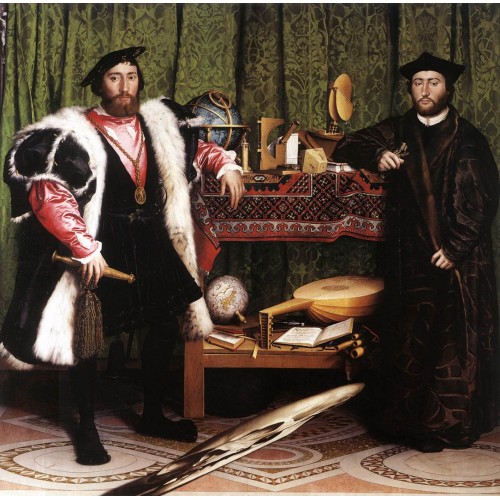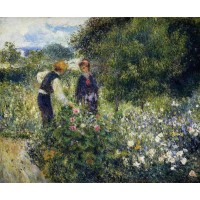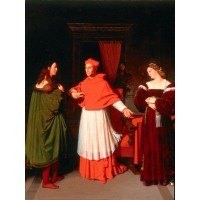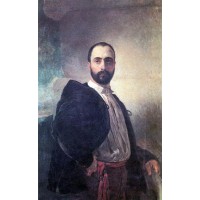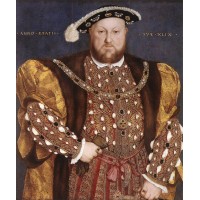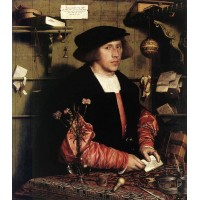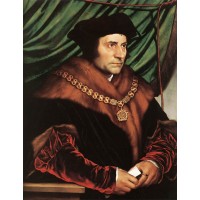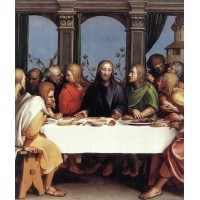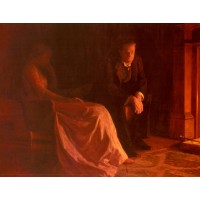The Ambassadors
- Artist: Hans Holbein
- Categories: Figure painting, Man painting, Renaissance-Northern, Famous paintings,
- Product Code: hans holbein 55
Available Options
The Ambassadors
Artist: Hans Holbein;
Oil painting on panel; Size: 207x209.5 cm; National Gallery, London.
The portrait painting by Hans Holbein, executed in 1533, was presented as an enigma, a "picture with a secret," in line with a custom that was to become common, especially in Germany. In fact the wealth of carefully described details is accompanied by an indecipherable figure in the foreground. The age of the figures is explicitly stated in the painting: twenty-nine is engraved on the dagger of the gentleman on the left, while the book on which the one on the right is leaning declares that he is twenty-four. The objects and details reflect the private life and political career of the subjects. In addition to the usual places, a portable globe indicates a small town called Polisy, home of the personage on the left: thus he is identified as the French ambassador Jean de Dinteville, wearing around his neck the medal of the Order of St. Michael that he had been awarded by Francis I. The young churchman is Georges de Selve, his friend and the papal ambassador. Both men were on a mission to London in 1533, as we are informed by the floor depicted in the painting: it is, in fact, the floor of the abbey of Westminster, political and religious symbol of England. The objects represented cover all the disciplines of the "quadrivium," the exact sciences: geometry, arithmetic, music and astronomy. In addition to the terrestrial globe, on which the route taken by Magellan in 1522 is traced, as a proof that the earth is round, there is a celestial globe, positioned in such a way as to indicate a precise date, but with reference to the latitude of Paris or Rome, and therefore alluding to the Vatican. The sundials and the torquetum or goniometer, a device used by Nicholas of Cusa to fix the position of the sun and stars, are a reminder of another portrait by Holbein, that of Nikolaus Kratzer, a German astronomer and friend of Thomas More, Desiderius Erasmus and Copernicus who had moved to London and was an ardent supporter of the idea that the earth moved around the sun. The open books in the painting portrait, on the other hand, are inscribed with two hymns by Luther, in reference to the mission of Bishop de Selve, an advocate of the need for a reconciliation between the Catholic and Protestant doctrines. But this is 1533: the Church of Rome has not accepted Henry VIII's divorce from Catherine of Aragon and marriage to Anne Boleyn, and so the king has declared himself head of the Church of England and the Anglican schism is looming, while Catholic France is engaged in a struggle with Charles V. A delicate mission, that of the French ambassadors, and one that had to avoid a rupture with England. But the lute depicted in the painting has a broken string and its case lies, upside down, on the ground, a sign of lack of harmony. The clasp of Jean de Dinteville's hat is a skull, a memento mori to ward off earthly vanity. And the strange shape in the foreground is also a skull, which is only revealed when viewed in a particular way: it is an anamorphosis, not recognizable unless looked at edgeways or with the aid of a curved mirror. Such symbols of death were sometimes included in portraits to put people on their guard against false pride and illusion.
The scene is set in front of a rich and heavy drape, like the ones that were generally raised to unveil a sacred vision or a revelation. De Selve believed in a God who could not be reached with reason alone, a God hidden in the heart of the believer: in profile and with the short arm of the cross turned toward us, a small silver crucifix is concealed in the first fold of the drape.
China Oil Painting Gallery supply The Ambassadors of Hans Holbein by customer sizes. 100% hand painted museum quality painting reproduction on canvas for sale . We can paint by any size. If you need a customer size that out of above list, please contact with us.

